The Philippine Statistics Authority (PSA) has released the official results of the 2024 Census of Population (2024 POPCEN), conducted nationwide with a census reference date of 01 July 2024. The census is part of the PSA’s core statistical programs under Republic Act No. 10625, and provides crucial data for planning, policymaking, and evidence-based governance.
The 2024 POPCEN was carried out alongside the implementation of the Community-Based Monitoring System (CBMS) to generate granular data that can support the assessment of poverty and welfare conditions at the barangay level.
Population of Marinduque Declines in 2024
Based on the results of the 2024 Census of Population, the total population of the Province of Marinduque was recorded at 226,522 individuals as of 01 July 2024. This figure is lower by 12,685 individuals or 5.3 percent compared to the 2020 population of 239,207 individuals.
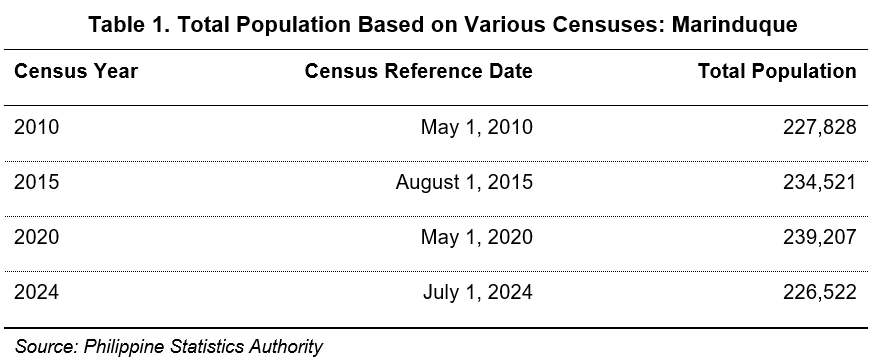
This marks a significant demographic shift, considering the steady increases observed in the three previous census periods. From 2010 to 2020, the province saw moderate population growth, which has now reversed over the most recent four-year period.
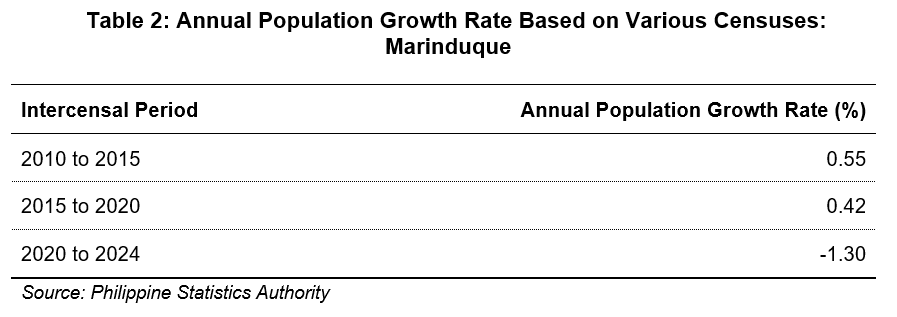
From 2010 to 2015, Marinduque’s population grew at an average of 0.55 percent annually, which slightly declined to 0.42 percent in the succeeding period from 2015 to 2020. However, this upward trend reversed sharply between 2020 and 2024, as the province recorded a negative annual population growth rate of -1.30 percent, confirming a population contraction.
Population Trends by Municipality, Marinduque (2010–2024)
All six municipalities registered population declines compared with 2020 figures. Boac, despite retaining its position as the most populous municipality, recorded a substantial decrease of 2,918 persons. Santa Cruz followed a similar trend, but posted the highest decline among six all municipalities, at 3,098 individuals. The other four municipalities showed further population reduction, with Torrijos at 1,941, Mogpog at 1,939, Buenavista at 1,907 and Gasan posted the lowest decline, at 882. Overall, the 2024 POPCEN reflects a downward population shift across all municipalities in Marinduque.
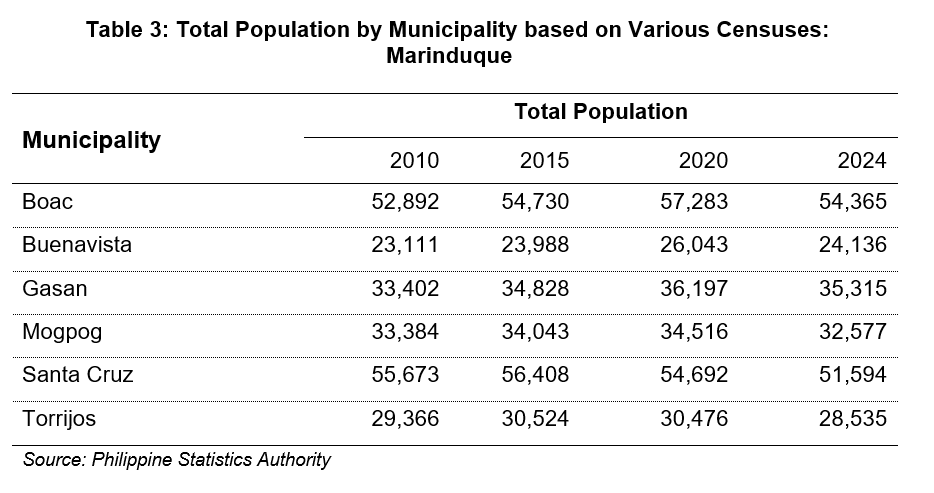
From 2020 and 2024, all six municipalities recorded negative annual population growth rates. Santa Cruz and Boac still topped as populous municipalities, yet both experienced annual decreases above 1 percent. Buenavista recorded the sharpest decline at -1.81 percent, reversing its earlier growth, while Gasan posted the smallest drop at -0.59 percent.
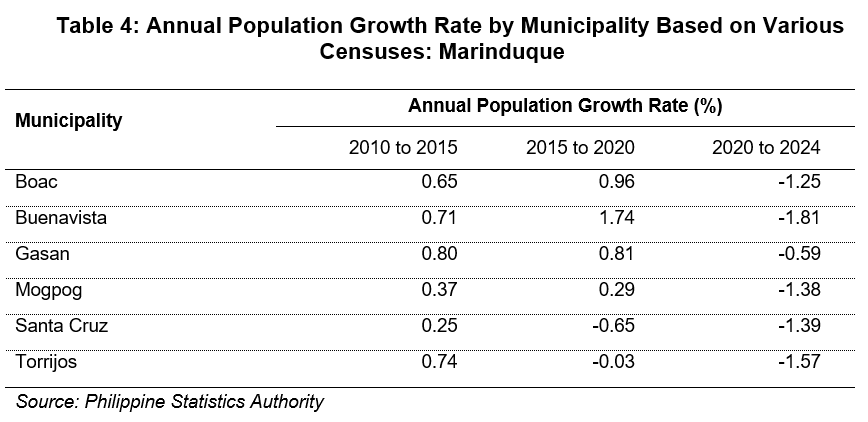
Ranking of Barangays by Population Size
Out of the 218 barangays in Marinduque, Daykitin in Buenavista emerged as the most populous in 2024, with 3,222 residents. It is followed closely by Yook, also in Buenavista, with 3,198 residents. The top ten most populous barangays are spread across six municipalities, with Buenavista, Torrijos, Santa Cruz, and Gasan and each contributing multiple entries.
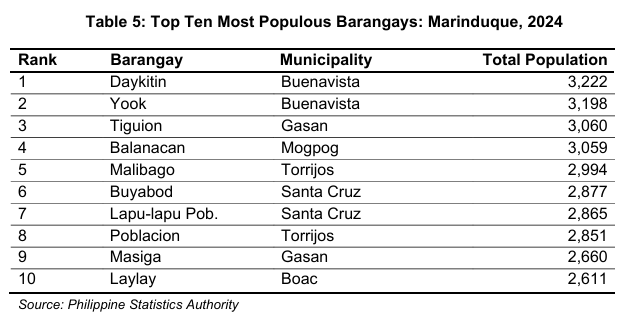
Meanwhile, San Miguel and Bayuti, both located in Boac, recorded the smallest populations in Marinduque, with only 113 and 115 residents, respectively. Boac accounts for six of the ten least populated barangays, indicating significant variations within the municipality. The list also includes Baguidbirin and Jolo in Santa Cruz, and Malayak and Mampaitan in Mogpog.
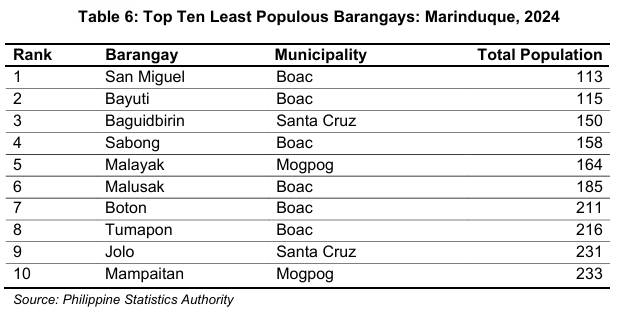
Marinduque Posts Largest Population Drop in MIMAROPA
While most provinces in the MIMAROPA region recorded positive population growth from 2020 to 2024, Marinduque saw a decline of 12,685 individuals, dropping from 239,207 to 226,522. In contrast, Palawan posted the largest increase, adding 29,201 residents (from 849,469 to 968,795), followed by Oriental Mindoro with 11,165 (from 908,339 to 919,504) and Puerto Princesa City with 9,305 (from 307,079 to 316,384). Meanwhile, Occidental Mindoro and Romblon experienced population decreases of 13,937 and 6,161, respectively.
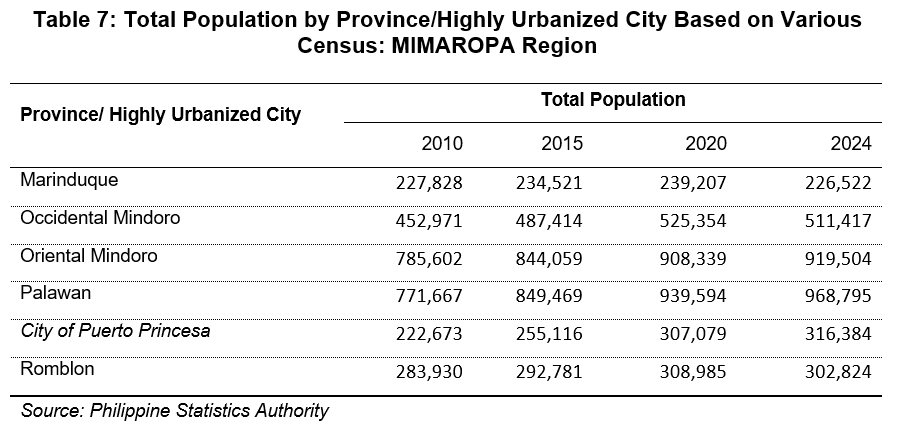
With a population share of 6.98 percent, Marinduque ranks lowest among all MIMAROPA provinces and its lone highly urbanized city. In contrast, Palawan (29.85 percent) and Oriental Mindoro (28.33 percent) together account for 58.18 percent, reflecting their demographic predominance in the region.
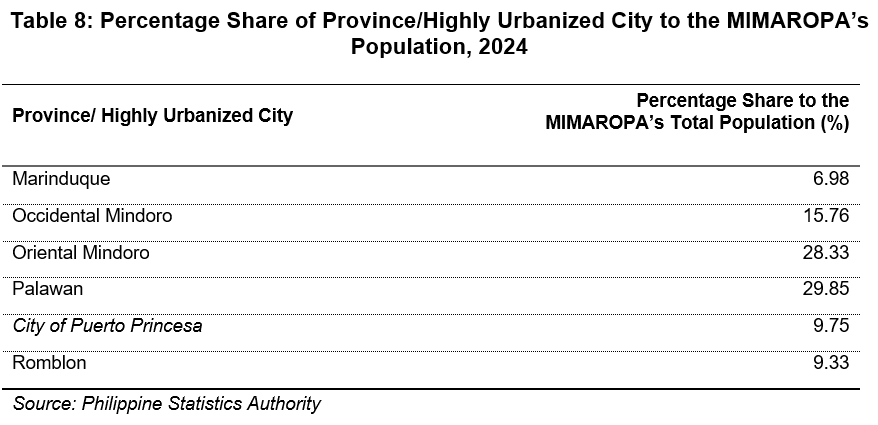
The population of the MIMAROPA region increased steadily from 2,744,671 in 2010 to 3,245,446 in 2024, marking an overall increase of over 500,000 individuals across 14 years. However, the most recent intercensal period (2020–2024) reflects a marked deceleration in growth, with an increment of only 16,888 persons, significantly lower than the 265,198, growth observed between 2015 and 2020.

The region’s annual growth rate dropped significantly to 0.13 percent in 2020–2024, following higher rates of 1.82 percent (2015–2020) and 1.47 percent (2010–2015), indicating a marked deceleration in population expansion.

Palawan registered the highest annual population growth rate (APGR) from 2020 to 2024 at 0.74 percent, followed by Puerto Palawan at 0.72 percent and Oriental Mindoro at 0.29 percent. In contrast, Occidental Mindoro (-0.64 percent), Romblon (-0.48 percent), and Marinduque (-1.30 percent) recorded negative growth rates, with Marinduque exhibiting the most pronounced population decline in the region.
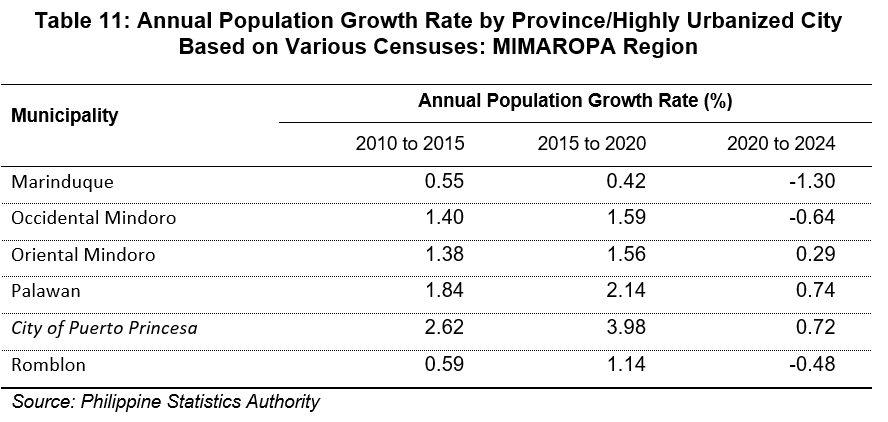
The 2024 Census of Population reveals key demographic shifts in MIMAROPA. Although the region's population continues to grow, the pace has slowed significantly from 2020 to 2024. Marinduque posted the steepest decline, both in absolute and percentage terms, marking a sharp reversal from its earlier growth trend.
In accordance with Batas Pambansa Blg. 72, the results of the 2024 POPCEN were officially proclaimed by His Excellency, President Ferdinand R. Marcos, Jr., confirming the total population of the Philippines at 112,729,484 as of 01 July 2024. These figures are detailed in the official publication, “2024 Census of Population: Population by Province, City/Municipality, and Barangay.”
This census serves as a vital instrument for ensuring that national and local development initiatives are responsive to the country’s dynamic demographic realities and are equitably aligned with the needs of all Filipino communities.
Approved for Publication:
(SGD)GEMMA N. OPIS
Chief Statistical Specialist
PSA Marinduque PSO
GNO/DJG

